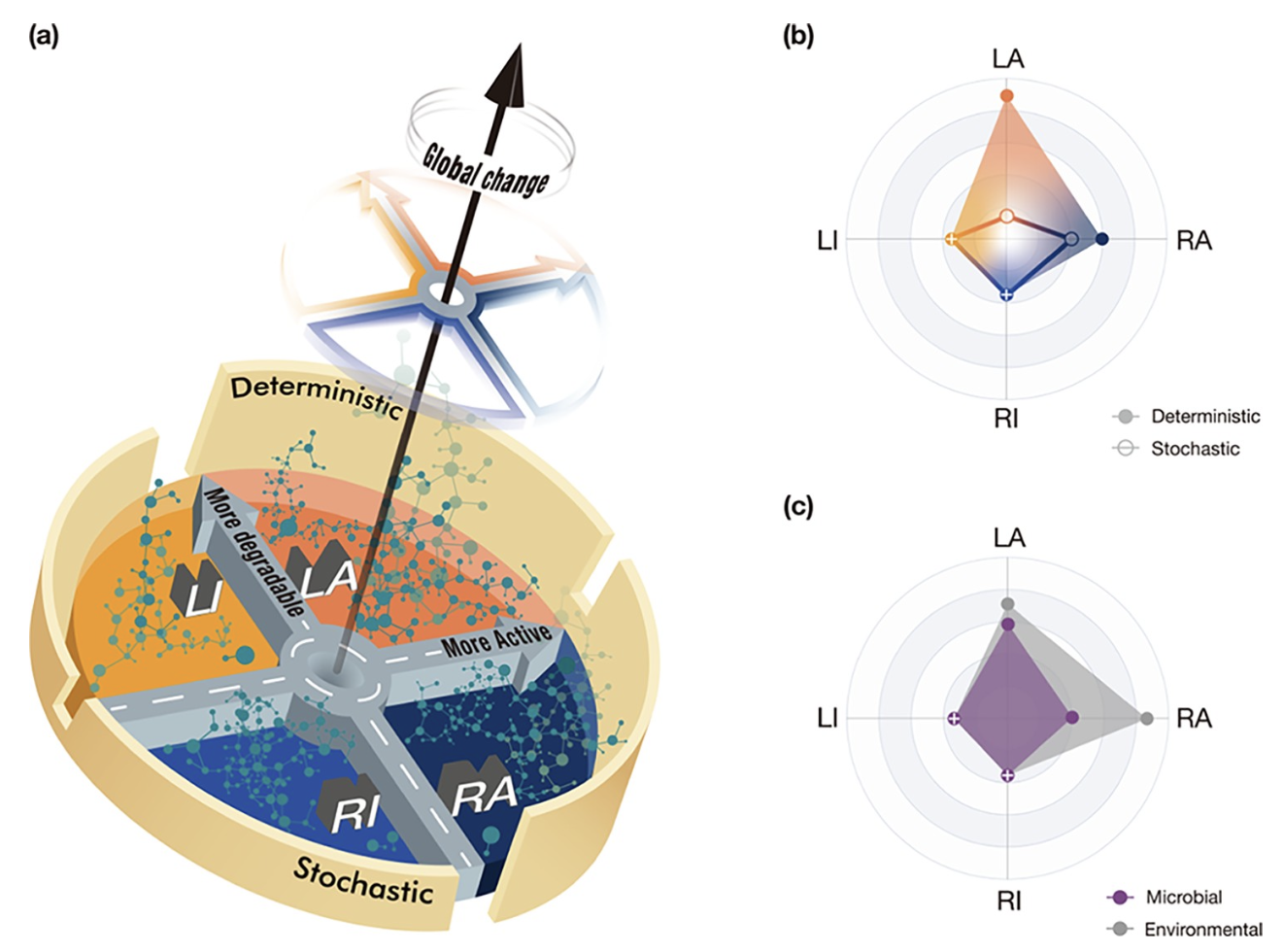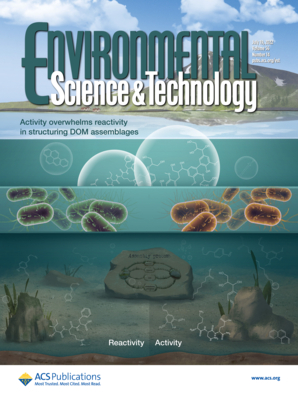Dissolved organic matter (DOM) is a complex and diverse mixture of labile and recalcitrant molecules that actively shape the biogeochemical cycles of all ecosystems on Earth. Compared to bulk carbon pools traditionally considered, the partitioning of organic matter into various fractions, such as particulate and mineral-associated pools or labile and recalcitrant pools, is improving predictions of the vulnerability of DOM to global change. However, individual molecules vary in their sensitivity to multiple simultaneous global change drivers, such as climate change and human activities. As such, there is a need to understand how the molecular composition of DOM and its dynamics respond to the synergistic effects of global drivers.
To address these challenges, we have developed a DOM Partitioning framework (DOMPart) that partitions DOM molecules into four fractions based on two orthogonal trait dimensions of molecular reactivity and activity: labile-active, recalcitrant-active, recalcitrant-inactive, and labile-inactive. Molecular reactivity is the capacity for a molecule to be degraded, and thus determines the type and potential biogeochemical function of compounds. For example, less biologically reactive compounds, such as recalcitrant molecules like lignin, are prone to persist in environments, whereas labile compounds like sugars are rapidly consumed by microbes 19. In contrast, molecular activity indicates the number of potential biochemical transformations that a molecule is involved in. Activity may better relate to the rate of biochemical processes or functions than reactivity, but it is not typically viewed as a molecular trait in previous literature.
We now have this framework and the relevant applications published in Environmental Science & Technology (Hu et al. 2022). More information is available at https://pubs.acs.org/doi/10.1021/acs.est.2c01432. Download PDF file.
Box 1. Glossary of terms for merging organic chemistry and ecology
Molecular reactivity: The capacity for a reaction of dissolved organic matter, which is constrained by molecular compounds or functional groups, and reflects the bioavailability and vulnerability to degradation (i.e., the degree of recalcitrance or lability). Quantified with metrics such as H/C ratio, aromaticity index, and double bond equivalents.
Molecular activity: The performance of a reaction involving the modification of dissolved organic matter. Quantified as the number of putative molecular transformations, i.e., the gain or loss of molecular groups between two DOM molecules. Gains and losses are quantified by mapping mass differences in pairwise m/z peak comparisons to a database of known mass differences transferred in common biochemical transformations (e.g., glucose and amines). Molecular transformations could relate to the rate of biochemical processes (or functions) and thus be used to distinguish relatively active from inactive molecules.
Labile fraction: Category of reactivity that includes DOM molecules with H/C ratio of ≥ 1.5; considered more bioavailable and less resistant to degradation.
Recalcitrant fraction: Category of reactivity that includes DOM molecules with H/C ratio of < 1.5; considered less bioavailable and more resistant to degradation.
Active fraction: Category of activity that includes molecules involved in numerous (e.g., > 10) molecular transformations.
Inactive fraction: Category of activity that includes molecules involved in few (e.g., < 1) molecular transformations.
DOM partitioning: Process of categorizing DOM molecules based on their molecular reactivity and activity: labile-active, recalcitrant-active, recalcitrant-inactive and labile-inactive molecules (Fig. 1a). It should be noted that the number of transformations a molecule is involved in represents a continuum of activity, and molecules with a relatively intermediate number of transformations (e.g., between 2 and 10) are excluded from the defined active and inactive fractions. Further development of the DOM partitioning framework could be used to include molecules with intermediate activity.
Energy supply: Energy is supplied to aquatic ecosystems in the form of organic carbon, which can be used as an electron donor for chemoorganotrophic metabolism of diverse microbial populations. Organic carbon is derived from multiple sources including terrestrial vegetation and phytoplankton. The energy supply could be influenced by a combination of global change drivers such as elevated temperature and nutrient enrichment.
Ecological processes: The processes that influence the composition of DOM are analogous to the ecological processes that control the assembly of biological communities. The processes include five components: variable selection, homogeneous selection, homogenizing dispersal, dispersal limitation, and drift. We considered selection-based assembly to be deterministic processes, while dispersal and drift were treated as stochastic processes. See Box 1 Figure.
Reference
Hu, A., K.-S. Jang, F. Meng, J. Stegen, A. J. Tanentzap, M. Choi, J. T. Lennon, J. Soininen, and J. Wang. 2022. Microbial and Environmental Processes Shape the Link between Organic Matter Functional Traits and Composition. Environmental Science & Technology 56:10504-10516. [pdf download]

Figure 1. A framework for studying the effects of global change on dissolved organic matter (DOM) composition.

Box 1 Figure. Ecological processes underlying DOM assemblages (i.e., metametabolome) analogous to ecological communities (i.e., metacommunities) and their transferable principles related to DOM organization. DOM can be assembled through selection, dispersal, drift, and evolutionary processes. These processes result in the production and/or degradation of DOM molecules (i.e., metabolites) which are akin to birth and/or death of organisms, respectively. Metabolite drift can be indirectly driven by ecological drift in microbial communities.

Cover image